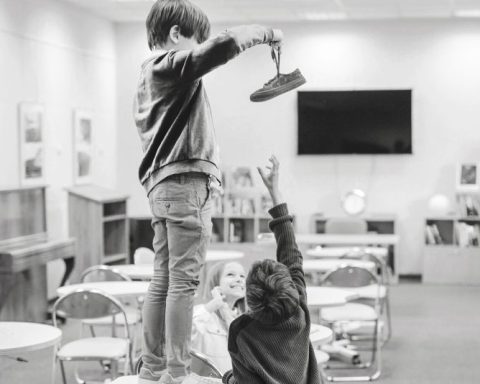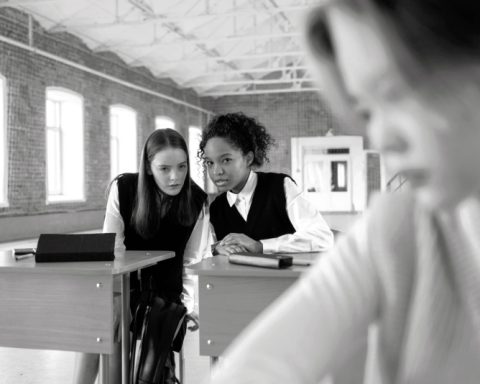Have you ever thought about how your child might react if they witness a classmate being bullied — whether they stay silent, join in, or take a stand? Or can you imagine your child being in a situation where they are the target of laughter or mockery? How do you think they would handle such an experience?
In today’s parenting journey, dealing with bullying is more than just understanding the traditional bully-victim scenario. It involves looking into various roles in bullying, like bystanders and upstanders. Also, acknowledging the sway of peer pressure is crucial. Remember, bullying isn’t a new issue; nearly 1 in 5 high school students faces it on school grounds.
Now, think about how these bullying situations might affect your child. How can you spot and handle these roles? Let’s dive into parenting amid different aspects of bullying, sharing tips and strategies to create a safe space for children.
Different roles in bullying
Learning the diverse roles in bullying is essential as it provides valuable insights into the dynamics at play, helping you comprehend the multifaceted nature of bullying. This understanding equips you to address and navigate these scenarios effectively. The usual roles observed in bullying scenarios include the following.
Bully
Bullies are those who initiate and engage in bullying behaviors. Behind bullies, there are also other roles involved in the situation:
- Assistants of the bully: Peers who do not initiate bullying but join in when someone else starts the aggression.
- Reinforcers of the bully: Children who encourage bullying by providing a supportive audience, laughing, inciting the bully, and more (also termed “bully’s followers”).
Characteristics and motivations of bullies can vary, but some common traits and tendencies have been identified through research. Here are some general characteristics and motivations associated with bullies.
- Dominance: Bullies seek to demonstrate control over peers or desired resources, using harassment as a means of exerting power.
- Revenge: Bullying can be a response driven by a desire to get back at someone or pressure them to perform better.
- Belonging: The need for acceptance and belonging drives bullying behavior to fit into a group or maintain social connections.
- Romance: Youths may use bullying to express romantic interest or eliminate perceived competitors in romantic pursuits.
- Identity: Bullying can be a tool to enhance one’s self-esteem or protect a positive self-image, particularly when peers attempt to damage it.
Read more: Types of Bullying: Different Ways Your Child Could Be Bullied
Victim
Victims are children targeted by bullying actions. Exposure to bullying is connected with mental health problems. Children who have experienced bullying are more likely to have negative thoughts about themselves and go through emotional distress, especially when dealing with feelings of sadness.
Looking at the bigger picture, those who were bullied as children face a higher chance of dealing with depression even up to 36 years later. These discoveries highlight how bullying can have a lasting and significant impact on mental health.
Bystander
Bystander bullying refers to when children observe a situation without actively participating or taking a side. There are two types of bystanders:
- Passive bystanders: Children who stay away from bullying situations, choosing not to take sides with anyone.
- Active bystanders: Children who actively intervene to defend the victim and stop bullying. They are also known as bullying upstanders.
Bystanders are a crucial part of bullying. This is why it’s essential to focus on bystander intervention — stepping in to help or stop bullying when it happens.
If you find your children acting as bystanders, guide them to take these five steps in bullying situations:
- Notice the event: Observe the situation and pay attention, especially focusing on vivid events with specific victims to grab attention.
- Interpret the event as an emergency: Recognize the situation as an emergency, overcoming the tendency to assume it’s not an emergency if others seem unconcerned.
- Accept responsibility for the intervention: Take personal responsibility to intervene, fostering empathy toward bullied peers for active involvement.
- Know how to intervene or provide help: Equip with the knowledge and skills to intervene effectively, overcoming self-doubt and fears.
- Implement intervention decisions: Take direct actions to stop the bullying or choose indirect methods such as reporting the incident or seeking help from a teacher or adult.
Read more: Stella O’Malley: Bullying – The Perpetrators, Victims, and How to Prevent | Raising Parents #12
The influence of peer pressure
Understanding the influence of peer pressure is crucial for navigating the complexities of bullying. Learning about peer pressure and its connection to bullying is essential for you as a parent because it lets you recognize, address, and guide your child through situations influenced by peer pressure.
Definition of peer pressure
Peer pressure is the impact of standards and expectations set by peers on an individual’s behavior, thoughts, and emotions. This influence emerges early in life, particularly as children engage with the social world beyond their immediate family or home.
According to the American Association for Community Psychiatry (AACP), peer pressure can be positive, providing support and aiding skill development for personal growth and learning. Conversely, peers may also exert a negative influence, encouraging risky behaviors like skipping classes, stealing, cheating, and substance use, potentially leading children down a harmful path.
Children might give in to negative peer pressure because they’re afraid of being left out or teased. Wanting to fit in and be accepted can push them to do things they wouldn’t normally do.
Peer pressure and bullying
As outlined above, children may follow the crowd and engage in behaviors like bullying if it appears acceptable or cool to the group.
In youth athletics, Nery et al. (2020) found instances where peer pressure led athletes to engage in behaviors outside the usual norms. Athletes, especially those deviating from the typical “ideal” image, may become targets for not being assertive or skilled enough.
This peer pressure can influence athletes to emulate the behavior of more popular peers, even if it involves bullying, in an attempt to fit in and be part of the perceived cool crowd.
In contrast to young athletes, regular children often take on the role of passive bystanders. Concerned about potential repercussions and harm to friendships, these children choose not to intervene, maintaining peace within their group and avoiding involvement in stopping the bullying.
Recognizing and addressing peer pressure
The AACP recommends that parents provide their children with the following guidance to empower them to resist negative influences and foster a positive peer environment:
- Be selective in choosing friends. Guide your child to choose appropriate peer groups, steering clear of those who may influence unsafe or inappropriate behaviors.
- Encourage assertiveness. Encourage them to develop assertiveness, empowering your child to say “no” confidently and practice handling uncomfortable situations.
- Foster positive connections. Create healthy connections with friends who are committed to resisting peer pressure and building a supportive network.
- Seek trusted guidance. In case of difficulties with peer pressure, advise your child to confide in a trusted adult — whether it’s a parent, teacher, or school counselor — for guidance and support.
Understanding the definition of peer pressure and its potential impacts equips you to guide your children effectively, navigating the complex dynamics of peer pressure and bullying for a safer environment in their development.
Preventive measures
Understanding preventive measures is crucial in creating a safe and supportive environment to address bullying effectively. By exploring school-based programs, community involvement, and the role of parents and teachers, you gain insights into collaborative strategies that contribute to preventing bullying.
Establish a coordinating team in the school
The role of school-based programs in bullying prevention is crucial. It involves establishing a coordinating team representing teachers, administrative staff, students, parents, and community members. Here is what the program can achieve:
- Regular collaboration: Work as a team to plan and execute bullying prevention activities, assess current initiatives, and select suitable programs.
- Direct engagement with students: Take a hands-on approach by actively involving students. Integrate skill development programs into the curriculum, focusing on recognizing bullying, conflict resolution, emotional management, accessing support, and assisting peers facing bullying.
- Comprehensive skill integration: Develop a curriculum that thoroughly includes essential skills, addresses the root causes of bullying, and promotes a secure school environment.
Implement community-led activities
In preventing bullying, involving the community using various approaches that create positive engagement is crucial. Here’s how the community contributes to preventing bullying:
- Extra support for schools: Act as additional resources to connect students, assisting in the educational setting.
- Bringing different skills: Groups in the community can contribute different skills to help with anti-bullying efforts. For instance, working with the police can bring programs to prevent gang violence to schools.
- Fun after-school activities: Start fun after-school clubs to keep children engaged in positive activities and lower the chances of them getting involved in bullying.
- Displaying positive messages: Create places to show positive messages, like having exhibitions of students’ work in local places. This could include student plays or events to teach people about preventing bullying.
Empowering the role of parents and teachers
Bullying prevention programs in schools may not be effective if children experience bullying or violence at home. Behaviors learned at home can carry over to school, underscoring the importance of parents and teachers working together to create a safe and supportive environment and prevent bullying.
Here are the approaches teachers can take to help parents address and prevent violence:
- Active involvement: Maintain active involvement and keep parents informed about violence prevention activities and school policies regarding violent behavior.
- Information dissemination: Share messages on how parents can actively support their child’s learning.
- Invitation to coordination: Invite parents to participate in violence prevention coordinating committees.
- Awareness-raising initiatives: Raise awareness among parents about recognizing and appropriately inquiring about violence. Equip parents with the knowledge to identify potential signs of bullying.
- Parenting program collaboration: Collaborate on parenting programs to enhance essential parenting skills and encourage non-violent approaches for managing challenging behavior.
Collaborating with teachers allows you to actively engage in various aspects of bullying prevention, from staying informed and involved to receiving support, fostering awareness, and participating in collaborative programs to enhance your parenting skills.
Read more: Stop the Cycle: Understanding Bullying in Kids and How to Prevent It
In conclusion
Understanding the various roles of bullying and the influence of peer pressure empowers you, as a parent, to support your child effectively. By staying informed and implementing specific strategies, you create a safe space for open conversations, essential for navigating social challenges.
Moreover, preventing bullying is a collective effort that involves parents, teachers, schools, and communities. Your active participation and awareness are crucial in fostering an environment that encourages positive interactions and the well-being of children.
Take a stand against bullying by promoting roles like upstanders and encouraging your children to interrupt, speak, and stop the bullying. Create a safer and more supportive community for your children.
If you would like to see more resources on bullying, check out the Parenting Science Labs. The lab uses the research of the Institute for Life Management Science to produce courses, certifications, podcasts, videos, and other tools. Visit the Parenting Science Labs today.
Photo by rawpixel.com on Freepik





